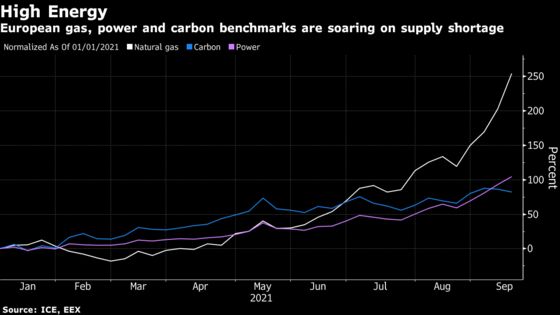
Green Push Leaves U.K. Energy Supply at the Mercy of Weather – EQ Mag Pro
The U.K.’s wind-power drive has dramatically cut carbon emissions, but it’s also created a vulnerability that’s been brutally exposed.
Calm weather over the past two weeks has cut output from the country’s 11,000 turbines, which account for more than 20% of electricity generation. Coupled with a Europe-wide gas shortage, the crunch has forced some companies to halt operations, which could hold back the economy if they become more widespread.
The disastrous combination is another headache for Prime Minister Boris Johnson at a time the country is already struggling with a shortage of workers that’s disrupted industry and retailers. On top of that, higher energy costs for consumers may damp the spending that’s helped drive the rebound from the pandemic recession.
The crisis could also spark a fresh backlash against renewable energy and net-zero emissions targets. That would make for an unwelcome backdrop as the U.K. prepares to host world leaders at a major climate summit — COP26 –- in a few weeks.
Britain plans to quadruple offshore wind capacity by 2030 as part of its efforts to be net zero by 2050. But a smooth transition from fossils to greener fuels isn’t guaranteed, and regular capacity crunches could become the norm. Along with worries about higher prices, that will make ambitious climate goals a much harder sell.
“This is going to be a political autumn crisis,” said Dieter Helm, professor of economic policy at Oxford University and energy policy adviser to the government. “It goes together with the delusion that people have that net zero is almost costless. It isn’t.”
The alternative to backtracking on the net-zero timetable is an overhaul of Britain’s power market to make it fit better with growing renewable usage rather than tinkering with a system based around the fossil fuels of the past.
While grid operators plan for intermittency in wind power, the latest drop coincided with a Europe-wide squeeze on natural gas, nuclear outages and a fire at a key power interconnector with France.
Britain has already turned to coal-burning stations to fill the energy shortfall, but there’s a gap emerging there. By 2024 there will be no more coal stations left, and five of the U.K.’s eight nuclear plants will also be halted permanently.
Electricite de France SA is building a new nuclear facility, Hinkley Point C, but it won’t be generating until 2026.
“The pace of decarbonization has taken everyone a bit by surprise but the challenge has been that the market structure that sits behind that hasn’t quite kept pace,” said Josh Buckland, a partner at Flint Global. “The nature of energy security has changed so it’s no longer a question of how many gigawatts of capacity you have on the system, it’s whether they are able to supply power at the right time

While gas has been the key energy source for the U.K., the country is heavily reliant on imports. Amid widespread shortages, governments could restrict gas exports to protect domestic industries, adding a protectionist and political dimension to the crisis. Yet, the U.K. government says that Britain’s access to diverse supplies of gas is an important factor to keep prices down.
“Soaring energy prices are sending costs for businesses spiraling and damaging industry, yet the government is nowhere to be seen,” said Ed Miliband, shadow energy secretary for the opposition Labour party.
Building more batteries could help ease the situation. Being able to store electricity when it’s cheap to use when demand is high is the ideal scenario to ease short-term squeezes. But Britain needs to invest more in this technology as renewable power becomes more widespread.
“We don’t need polluting coal or gas, or nuclear power which might not be working when we need it the most,” said Kit Dixon, policy manager at Good Energy, which owns Delabole, the U.K.’s first commercial wind farm. “A backbone of wind and solar, supported by tidal, geothermal, and extensive electrical storage can help us cut carbon, while keeping the lights on and the radiators warm in even the most challenging weather conditions.”



















